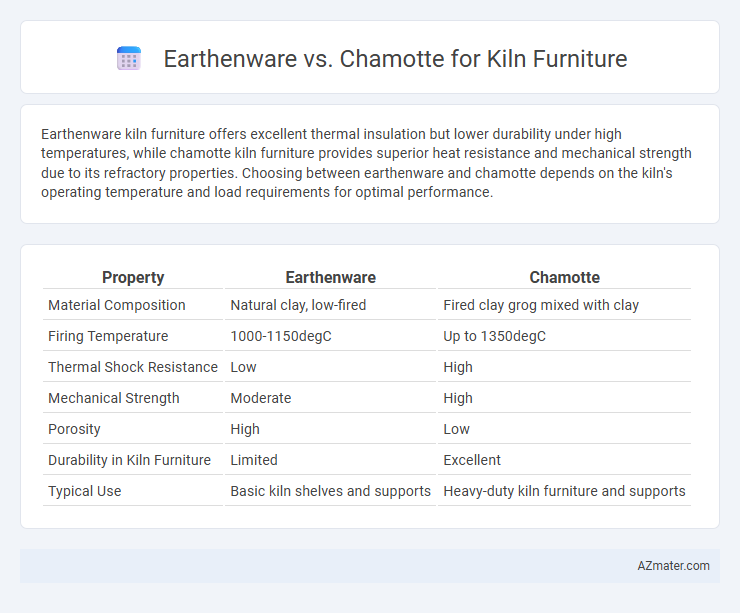Earthenware kiln furniture offers excellent thermal insulation but lower durability under high temperatures, while chamotte kiln furniture provides superior heat resistance and mechanical strength due to its refractory properties. Choosing between earthenware and chamotte depends on the kiln's operating temperature and load requirements for optimal performance.
Table of Comparison
| Property | Earthenware | Chamotte |
|---|---|---|
| Material Composition | Natural clay, low-fired | Fired clay grog mixed with clay |
| Firing Temperature | 1000-1150degC | Up to 1350degC |
| Thermal Shock Resistance | Low | High |
| Mechanical Strength | Moderate | High |
| Porosity | High | Low |
| Durability in Kiln Furniture | Limited | Excellent |
| Typical Use | Basic kiln shelves and supports | Heavy-duty kiln furniture and supports |
Introduction to Kiln Furniture Materials
Kiln furniture materials play a critical role in supporting ceramics during firing, with earthenware and chamotte being two commonly used options. Earthenware is a porous, low-fired clay body known for its affordability and ease of shaping, but it lacks the thermal resistance of chamotte, which contains grog or calcined fireclay to enhance strength and durability at high temperatures. Chamotte kiln furniture withstands repeated thermal cycles and provides superior structural integrity, making it ideal for demanding firing environments.
What is Earthenware?
Earthenware is a porous, low-fired ceramic material commonly used in kiln furniture due to its affordability and ease of shaping. It typically fires between 1,000degC and 1,150degC, making it suitable for lower temperature firings but less durable under extreme heat compared to chamotte. In contrast, chamotte contains grog additives that enhance thermal shock resistance and mechanical strength, ideal for higher-temperature kiln applications.
What is Chamotte?
Chamotte is a refractory material made from crushed, fired clay that is added to earthenware to enhance its thermal resistance and mechanical strength in kiln furniture applications. It provides superior durability and stability at high temperatures, reducing warping and extending the lifespan of kiln shelves and supports. Its coarse, granular texture improves heat distribution and structural integrity compared to standard earthenware.
Material Composition: Earthenware vs Chamotte
Earthenware for kiln furniture consists primarily of natural clay and contains a high proportion of fluxes and impurities, resulting in a lower firing temperature typically between 1000degC and 1150degC. Chamotte, on the other hand, is composed of crushed grog or fired clay particles mixed with refractory clay, enhancing its thermal shock resistance and durability at higher temperatures up to 1400degC. The inclusion of chamotte increases the material's porosity and structural strength, making it ideal for sustained use in industrial kiln environments.
Thermal Resistance and Performance
Earthenware kiln furniture offers moderate thermal resistance, typically withstanding temperatures up to 1200degC, making it suitable for low to mid-fire ceramic processes. Chamotte kiln furniture, composed of grog-fired clay, provides superior thermal performance with resistance exceeding 1400degC, ensuring durability and stability during high-temperature firings. The higher thermal shock resistance and structural strength of chamotte results in longer-lasting kiln furniture with better performance under rapid temperature changes.
Durability and Longevity Comparison
Earthenware kiln furniture, composed primarily of clay, offers moderate durability but tends to wear down faster under high temperatures and frequent firing cycles. Chamotte kiln furniture, made from refractory clay mixed with grog, provides superior durability and longevity due to its enhanced resistance to thermal shock and mechanical stress. This makes chamotte a preferred choice for kilns subjected to intense heat and continuous use, ensuring extended service life and reduced replacement costs.
Weight and Handling Considerations
Earthenware kiln furniture is generally lighter than chamotte, making it easier to handle and transport during kiln loading and unloading. Chamotte, composed of fireclay mixed with grog, offers higher density and weight, providing superior stability and durability under high temperatures but increasing handling difficulty. Weight considerations impact workflow efficiency, with earthenware favored for lighter tasks and chamotte preferred for heavy-duty applications requiring robustness and resistance to thermal shock.
Cost and Availability Analysis
Earthenware kiln furniture is generally more affordable and widely available due to its lower firing temperature and simpler manufacturing process. Chamotte, composed of ground fireclay and grog, offers higher durability for high-temperature firings but comes at a premium cost and limited availability in some regions. Choosing between them depends on balancing budget constraints with the thermal demands of the kiln environment.
Best Use Cases for Earthenware Kiln Furniture
Earthenware kiln furniture excels in low to medium temperature firings, making it ideal for bisque firing and glaze firings below 1200degC. Its porous structure allows excellent thermal shock resistance and lightweight handling, suitable for delicate pieces and short firing cycles. Chamotte kiln furniture, with higher thermal stability and strength, is better for high-temperature firings above 1300degC, often used in stoneware and porcelain production.
Best Use Cases for Chamotte Kiln Furniture
Chamotte kiln furniture excels in high-temperature firings due to its enhanced thermal shock resistance and structural strength, making it ideal for prolonged use in industrial and ceramic kilns operating above 1200degC. Its coarse, refractory properties allow it to support heavy loads without deformation, beneficial for dense stoneware or porcelain pieces requiring stable, uniform heat distribution. Chamotte's durability reduces maintenance and replacement frequency, enhancing kiln efficiency and cost-effectiveness compared to earthenware kiln furniture, which suits lower temperature applications and lighter loads.

Infographic: Earthenware vs Chamotte for Kiln Furniture
 azmater.com
azmater.com